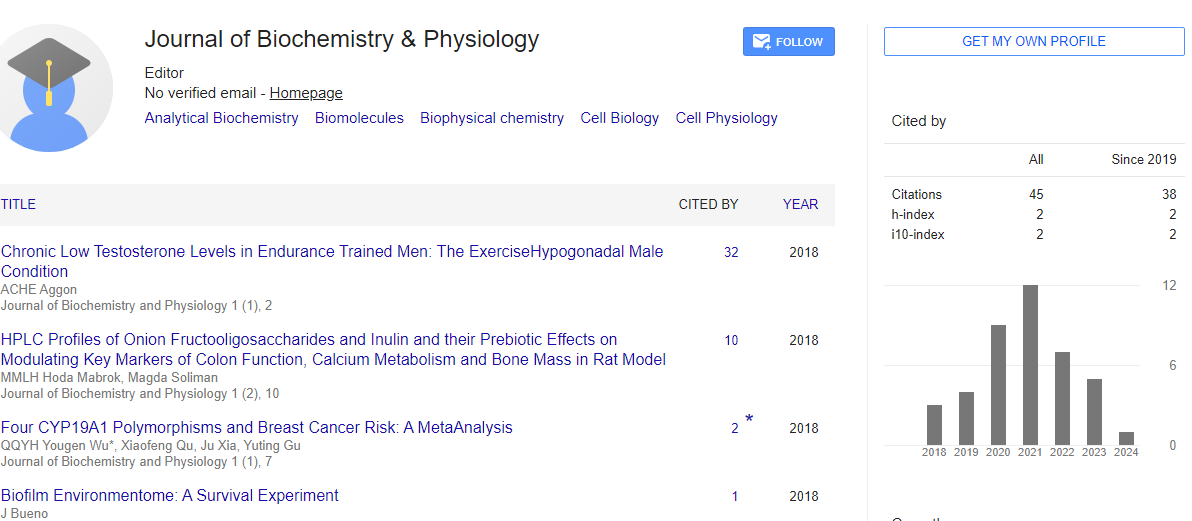Commentary, J Biochem Physiol Vol: 7 Issue: 1
Role of Lipids in Cellular Signaling Pathways: Insights from Biochemical Studies
Chai Hun*
1Department of Clinical Biochemistry, National Institutes of Health, Bethesda, MD, USA
*Corresponding Author: Chai Hun,
Department of Clinical Biochemistry, National
Institutes of Health, Bethesda, MD, USA
E-mail: hunch@i.edu
Received date: 19 February, 2024, Manuscript No. JBPY-24-134959;
Editor assigned date: 21 February, 2024, PreQC No. JBPY-24-134959 (PQ);
Reviewed date: 11 March, 2024, QC No. JBPY-24-134959;
Revised date: 20 March, 2024, Manuscript No. JBPY-24-134959 (R);
Published date: 29 March, 2024, DOI:10.4172/jbpy.1000156.
Citation: Hun C (2024) Role of Lipids in Cellular Signaling Pathways: Insights from Biochemical Studies. J Biochem Physiol 7:1.
Description
The intricate network of cellular signaling pathways governs essential cellular processes, ranging from proliferation and differentiation to metabolism and apoptosis. Within this complex web of signaling, lipids emerge as pivotal players, exerting multifaceted roles beyond their conventional structural functions. Biochemical studies have unveiled the diverse ways in which lipids orchestrate cellular signaling events, shedding light on their significance in cellular physiology and disease pathogenesis.
Lipids, once primarily viewed as passive membrane components, are now recognized as active participants in cellular signaling. Phospholipids, sphingolipids, sterols, and lipid-derived mediators serve as signaling molecules themselves or as precursors for the synthesis of bioactive lipid mediators. For example, Phosphatidylinositol Bisphosphate (PIP2) and Phosphatidylserine (PS) act as critical signaling intermediates, modulating the activity of various signaling proteins.
Biochemical studies have provided invaluable insights into the mechanisms by which lipids regulate cellular signaling pathways. These studies have elucidated the role of lipid microdomains, such as lipid rafts, in organizing signaling complexes and facilitating signal transduction. Moreover, biochemical approaches, including lipidomics and mass spectrometry, have enabled the identification and quantification of lipid species involved in specific signaling pathways.
Lipid rafts, specialized membrane microdomains enriched in cholesterol and sphingolipids, serve as platforms for the spatial and temporal organization of signaling molecules. Biochemical studies have revealed the dynamic nature of lipid rafts and their involvement in receptor-mediated signaling, membrane trafficking, and cellular communication. Lipid raft disruption alters signaling events, highlighting their importance in cellular physiology and pathology.
Post-translational lipid modifications play a crucial role in regulating the localization, activity, and interactions of signaling proteins. Biochemical studies have elucidated the mechanisms of lipid modification, such as palmitoylation, myristoylation, prenylation, and lipidation with phosphoinositides. These modifications serve as membrane-targeting signals, directing proteins to specific subcellular compartments where they participate in signaling cascades.
Biochemical studies have unraveled the intricate signaling pathways modulated by lipids, including phosphoinositide signaling, eicosanoid signaling, and sphingolipid signaling. For example, phosphoinositide-derived molecules, such as Diacylglycerol (DAG) and Inositol Trisphosphate (IP3), regulate intracellular calcium levels and Protein Kinase C (PKC) activation. Eicosanoids, derived from arachidonic acid, mediate inflammatory responses through G-Protein- Coupled Receptors (GPCRs).
Dysregulated lipid signaling pathways are implicated in various diseases, including cancer, cardiovascular disorders, and neurodegenerative diseases. Biochemical studies have provided insights into the role of lipid metabolism and signaling in disease pathogenesis. Aberrant lipid signaling contributes to cancer progression, inflammation, insulin resistance, and atherosclerosis, highlighting lipids as potential therapeutic targets.
Biochemical studies have paved the way for the development of therapeutic interventions targeting lipid signaling pathways. Small molecules targeting lipid metabolic enzymes, lipid kinases, or lipidbinding proteins hold promise for the treatment of various diseases. Moreover, lipid-based therapeutics, such as lipid nanoparticles and liposome-based drug delivery systems, offer novel approaches for drug delivery and targeted therapy.
Conclusion
Biochemical studies have illuminated the critical role of lipids in cellular signaling pathways, providing insights into their involvement in cellular physiology and disease pathogenesis. From serving as signaling molecules to modulating the activity of signaling proteins, lipids exert diverse effects on cellular signaling events. Understanding the biochemical basis of lipid-mediated signaling pathways holds promise for the development of innovative therapeutic strategies targeting lipid metabolism and signaling in disease.
 Spanish
Spanish  Chinese
Chinese  Russian
Russian  German
German  French
French  Japanese
Japanese  Portuguese
Portuguese  Hindi
Hindi 